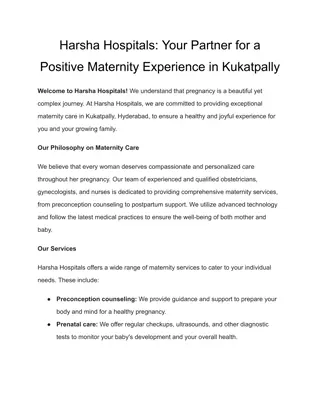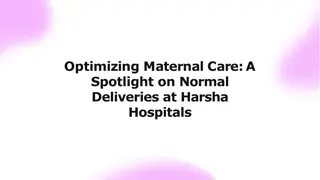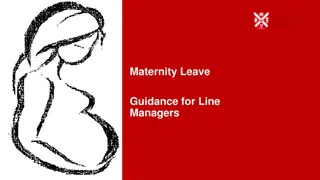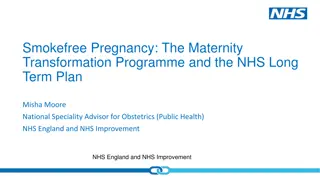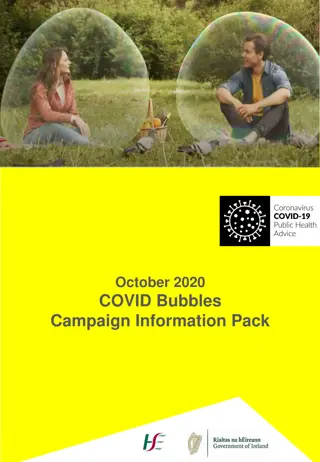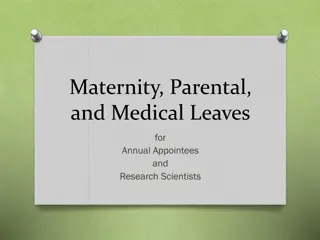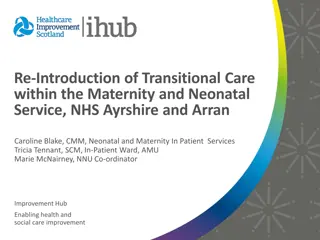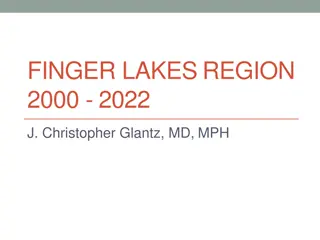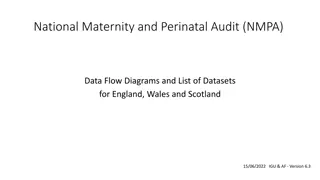Creating a Successful Campaign and Leading Change in Maternity Care
As part of the Each Baby Counts Learn and Support Programme, a campaign titled "IDENTIFY. COMMUNICATE. ACT." was launched to improve clinical escalation in maternity care across England. By developing and implementing interventions, the team aimed to address issues identified in reports, such as Ockenden, and enhance standardization in NHS maternity units. The guide outlines steps on successfully launching these interventions, from preparing a dedicated team to planning the launch day with a focus on staff engagement and feedback.
Download Presentation

Please find below an Image/Link to download the presentation.
The content on the website is provided AS IS for your information and personal use only. It may not be sold, licensed, or shared on other websites without obtaining consent from the author.If you encounter any issues during the download, it is possible that the publisher has removed the file from their server.
You are allowed to download the files provided on this website for personal or commercial use, subject to the condition that they are used lawfully. All files are the property of their respective owners.
The content on the website is provided AS IS for your information and personal use only. It may not be sold, licensed, or shared on other websites without obtaining consent from the author.
E N D
Presentation Transcript
Creating a Successful Campaign and Leading Change
Introduction Introduction As part of Each Baby Counts Learn and Support Programme a network of midwives and obstetricians from across England worked together to improve the culture, behaviours and conditions to enable effective clinical escalation in maternity. This was done through a campaign called IDENTIFY COMMUNICATE - ACT . It sought to address the problems identified in Each Baby Counts reports, and national inquiries (such as Ockenden), together with the diagnostic phase of the programme, putting recommendations into action. The team then developed, tested and refined 3 interventions which can be rolled out in all maternity units around the country, with the aim of improving standardisation across the NHS.
How To Guide How To Guide - - Successfully Launching the Successfully Launching the Interventions (1) Interventions (1) Get prepared. Gather a team around who are all going to be champions and support the project, with a designated lead. Set up regular meetings to review progress including performance metrics. Key people could include an obstetric consultant, an anaesthetist, a midwifery matron, intrapartum midwives, obstetric trainees. Get high level buy in and support explain your plans to the senior leadership team. This could include the head and director of midwifery, clinical director, labour ward lead, obstetric anaesthetic lead. Create a timeline and a plan.
How To Guide How To Guide - - Successfully Launching the Successfully Launching the Interventions (2) Interventions (2) Consider undertaking some simple diagnostics to understand the culture of your unit Identify your potential barriers and consider solutions to overcome them (eg if a particular staff group are resistant to change, consider a presentation at a key meeting). Collate your campaign materials. These can include posters, pens, T-shirts for the implementation team, and business cards to hand out to staff and raise awareness. Merchandise works!
How To Guide How To Guide - - Successfully Launching the Interventions (3) Launching the Interventions (3) Successfully Plan your launch day including ways of disseminating the ideas to staff. This will usually involve an introductory email to all staff, followed by presence on the shop floor, at handovers. Plan presentations at teaching sessions including CTG teaching and in house skills training. Get baking everyone loves cake and it helps staff feel cared for and nurtured while you re on the shop floor explaining the change ideas. Identify early adopters and recruit them as champions. Celebrate wins, keep staff updated with (hopefully) good news. Be receptive to feedback and be willing to change your approach if it isn t working.
Creating a communication plan Creating a communication plan Create a name for your campaign Include a strapline rule of 3 repeated at least 6 times Throughline of the key aims Create a high level summary summarising key aims and activities Create a list of key messages to be repeated throughout
Our throughline Our throughline Helping maternity units to build the right culture, behaviours and conditions that enable effective clinical escalation
Our throughline broken down Helping maternity units Build the right culture Raises awareness and provides tools to help staff in maternity units Ensures staff feel psychologically safe to speak up without fear of repercussion Behaviours Staff listen and are respectful, inclusive and kind Conditions It is easy and simple to do Enables Allows, assists, supports Effective Clinical Escalation Successful Communicating a concern related to the clinical care of the woman and baby in order to achieve an appropriate response
From Good to Great From Good to Great Communication Communication Outcomes if we achieved this what would it look like? A reduction in unnecessary delays in the escalation process Improvement in response and action taken Improvement in the use of safety critical language A supportive environment which helps staff who are fearful of speaking up without repercussions Having the right level of information (succinct as possible) and improve consistent sharing of information A reduction in the feelings of hierarchy Embedding ways to thank staff and give positive feedback showing respect and kindness Improving our listening and involvement of women
Promoting Excellence in Teamwork Promoting Excellence in Teamwork Outcomes if we achieved this what would it look like? Improved debrief from previous shift and briefing for the following shift Closing the shift and checking out sensitively - people going home emotionally safe and on time Having the right people at the right time A safe environment which helps staff who are fearful of speaking up without repercussions A reduction in the feelings of hierarchy and inability to escalate valid concerns A way to thank staff and give positive feedback when things have been escalated and gone well to show gratitude and kindness Improvements in our listening to and involvement of women
Positive Changes Seen in Units Who Have Implemented these Interventions Teach or Treat AID TOS Escalation made more precise and direct Similar to sign in and sign out of the surgical checklist Staff feel more empowered, confident and psychologically safe to ask questions Standardized conversations Great to identify who was there/skill mix for shift Promoted learning environments Better than SBAR Supportive of staff s individual needs Rationales behind decision-making explained Especially helpful for night shift calls Helped students, junior and new staff Women find it reassuring and respectful Staff more confident when escalating to consultants Staff feel appreciated Framework for concise communication Most improvement in communication between Band 7 coordinators and consultants
Positive Change Ideas Positive Change Ideas - - Embedding the Interventions Embedding the Interventions Embed throughout training - talk to midwifery students, rotating doctors at induction, PROMPT, mandatory training Implement across whole MDT including MSWs, nurses, anaesthetists, neonatologists Include in human factors and safety training Lead by example role modelling at every shift, every handover Include women during tool usage Build a common language Promote use of tools and safety nets and empowerment of staff Explain rationale of tools and reward their use Use examples that have worked before e.g. hello my name is campaign Use your fetal monitoring and education leads
Challenges Faced by Other Units (but were successfully Challenges Faced by Other Units (but were successfully overcome) overcome) Getting some groups of people on board can be hard engage early adopters Multiple competing priorities in maternity care, seen as yet another initiative sell the positives; easy to achieve, makes staff and patients safer. Not enough people to roll out create a big home team Some people are good with a structured approach (SBAR) others aren t When you are busy you need the safety nets but when you are busy you find it hard to implement the safety nets dilemma Variation in the way handovers are done depending on the lead - this is what team of the shift seeks to address Tackling the it s always been like that culture create a positive movement for change
Each Baby Counts Learn & Support Example Key Messages for Clinical Escalation Interventions
Change ideas and change methodology Campaign: Identify - Communicate - Act (Response) ACT (AND RESPOND) - Teach or Treat IDENTIFY COMMUNICATE -Use concise, safety critical language to communicate concerns and SBAR. Respond kindly, quickly and appropriately using Team of the shift: Use checklist for setting up team of the shift with visuals and prompts. TEACH Tell me what you think and why, I ll do the same so we can discuss Begin conversation with: Knowledge and skills: Develop educational material re knowledge, tools, escalation process: increasing conscious awareness I need advice or I need to inform TREAT Lets take action to the clinical escalation I need a response
Interventions Developed and Tested Using QI Methodology Interventions Developed and Tested Using QI Methodology TOS Promoting excellence in team working AID Safety critical language Teach or Treat Learning conversations All aim to improve clinical escalation, psychological safety for staff, and provide a structured way of improving communication and behaviour change.
Key Messages Key Messages Team of the Shift Team of the Shift Team of the Shift will help build effective teamworking, civility and psychological safety it will help build the behaviours that support safe working environments It will help identify who is who and the right people to escalate to It will be used to check out from the previous shift and check in for the forthcoming shift, promoting kindness
Key Messages Key Messages Advice, Inform, Do Advice, Inform, Do Effective communication is vital to maintaining safety within maternity units and helps to build teamwork, psychological safety and civility We will implement a systematic and a structured communication tool to be used when escalating AID Advice, Inform, Do - to help people ask for advice or to inform or to achieve a response
Key Messages Key Messages Teach or Treat Teach or Treat The team will implement Teach or Treat to support respectful and appropriate responses to clinical escalation, strengthening learning conversations between multi- disciplinary team colleagues Respond kindly, quickly and appropriately to escalated concerns (Treat) or explain WHY you are not concerned (Teach)
Each Baby Counts Learn & Support Example Infographic Summary
Promoting respectful learning conversations between colleagues. Respond kindly, quickly and appropriately using Team of the shift: Promoting excellence in teamwork. At the start of each shift, ask yourself... Do I know everyone on shift today? Do I know who I'm going to escalate concerns to? Have I said thank you to a colleague? Have we celebrated our successes together? Have I checked if my colleagues are okay at the beginning and end of each shift? Make clinical escalation precise and concise using safety critical language to communicate concerns TEACH Tell me what you think and why, I ll do the same so we can discuss or TREAT Let s take action to the clinical escalation Begin conversations with: I need Advice I need to Inform I need you to Do



